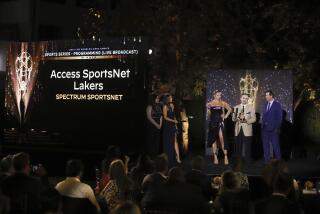Wireless Cable Operator Eyes L.A.
In an initiative that could do more to lower cable bills than the Federal Communications Commission’s latest rate cut proposal, a wireless cable operator plans to offer 150 channels of programming by late next year in Los Angeles and Orange counties.
Cross Country Wireless Inc., based in Riverside, has already signed up 42,000 customers in Riverside and San Bernardino counties, prompting cable operators there to lower their rates and expand service to stay competitive.
The company transmits cable TV and broadcast channels into homes using microwaves, rooftop antennas and in-home converter boxes. It charges $18.95 a month for 26 broadcast and cable channels. Movie channels range from $4 to $7 each. There is no installation fee. Those prices undercut local cable competitors by $3 to $5 a month.
The principal drawback to the wireless system is that its signal cannot reach into some obstructed locations, such as canyons.
As it expands, Cross Country plans to offer 150 channels, with up to 40 of those dedicated to interactive classroom programs by participating colleges in Orange and Los Angeles counties. Several stations would be dedicated to non-English programming, said Peter Frank, Cross Country president.
Wireless cable, which has been around for 20 years, has been hampered by transmission technology problems and by limited access to programming. But with the development of digital technology, which compresses data so that a single broadcast channel can be turned into four or five, wireless is about to take off, its proponents say.
One of those true believers is Lowell Hussey, former senior vice president of marketing and programming for Time Warner Cable TV. He retired in 1990 at age 37, promising himself that he wouldn’t come back into the business until cable had a viable competitor.
He signed on eight months ago as operations director of Cross Country, which claims to be the largest privately held wireless company in the nation.
“I said, ‘Aha! At last!’ It’s better than I thought it would be,” said Hussey, who is on the road a lot these days, setting up expansion deals throughout the country.
Until the 1992 Cable Act, Hussey said, the wireless industry was denied access to much programming. That hindrance, which had been encouraged by the powerful cable TV lobby, made it difficult for wireless companies to attract investors. The 1992 law made it illegal to withhold programming.
Today, the six public wireless companies together have raised $500 million in the equity markets and are in the process of borrowing more, according to the Wireless Cable Assn. International in Washington.
Cross Country began offering service to the Inland Empire market by working with colleges and a church diocese in the area to apply to the Federal Communications Commission for a shared license. Some of the groups already had licenses to lease to Cross Country.
The procedure anticipated an April, 1992, FCC freeze on new licenses.
Cross Country plans a similar strategy in Los Angeles and Orange counties, said company president Frank. He said the agreements are nearly completed.
Other cable competitors are also in the digital race. Pacific Bell and GTE California Inc. have said they will wire homes and schools for interactive programming.
And DirectTV, a partnership between a division of Hughes Aircraft Co. and United States Satellite Broadcasting, said it will introduce small-dish satellite TV service as early as April.
Cable Without Wires
Wireless cable television could enter the Orange and Los Angeles markets by next year to compete with cable companies. It would start service with 33 channels, but with anticipated developments in digital and compression technology, could expand to 150. How wireless cable works:
Apartment building with MATV system.
Private homes.
Satellite receive station. 1. Programming is beamed via satellite to a receive/transmit station. 2. Signal is converted for multichannel, multi-point distribution. 3. Signal is transmitted via microwave. 4. Signal is picked up by antenna and converter and re-formed for TV reception. 5. Signal travels to a decoder box atop television, where it is unscrambled for viewing.
Advantages * Less downgrading of signal in transmission. * Less equipment to malfunction and increase costs.
Disadvantages * Microwaves travel in straight lines, so antenna must be placed in line of sight of transmitter. * Limited programming. Source: Wireless Cable Assn. International Researched by JANICE L. JONES / Los Angeles Times
More to Read
The biggest entertainment stories
Get our big stories about Hollywood, film, television, music, arts, culture and more right in your inbox as soon as they publish.
You may occasionally receive promotional content from the Los Angeles Times.










